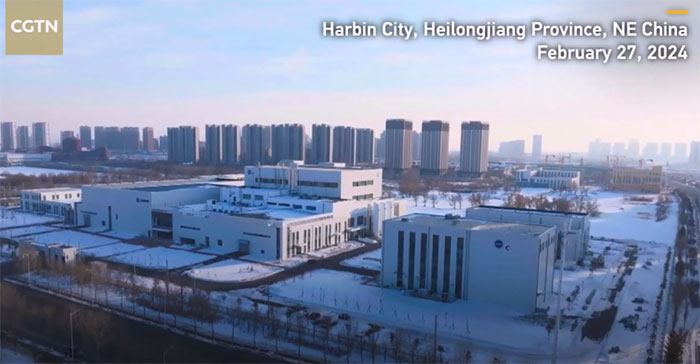China's first underground space station
The new facility with the ability to simulate 9 types of space station environmental factors allows conducting many space experiments right on Earth .
(Video: CGTN)
The Space Environment Simulation and Research Infrastructure (SESRI), dubbed China's first terrestrial space station , passed the acceptance evaluation process in Harbin, capital of Heilong province Jiang, northeast China, on February 27.
"This achievement means that many experiments that previously had to be performed in space can now take place on the ground ," said Li Liyi, head of the Institute of Space Environmental Research and Materials Science at the Institute of Space Environment and Materials Science. Harbin Technology (HIT), said.
The ground space station was jointly built by HIT and China Aerospace Science and Technology Corporation. In the construction area, there are 4 experimental buildings including: comprehensive space environment, space plasma science, space magnetic environment science and animal breeding place.
According to the plan , the ground space station can simulate 9 types of space environmental factors such as vacuum, high and low temperatures, charged particles, electromagnetic radiation, space dust, plasma, weak magnetic fields. , neutral gas and microgravity. The station can help explain the mechanisms and laws of the impact of the space environment on materials, devices, systems, and even living organisms.

Ground space station built by China.
Compared to sending equipment and instruments to space, a space station on the ground saves costs, reduces danger, and provides the ability to control certain environmental factors based on scientific requirements. technique. This allows studies to be repeated multiple times without limitations of time or space.
The terrestrial space station plays an important role in creating scientific and technological breakthroughs, transforming and upgrading industry, and cultivating high-end talents in China, according to Han Jiecai, a scholar of the Korean Academy of Sciences. Forestry of Science of China. In the future, HIT will continuously optimize technical indicators and improve the station's scientific level to contribute to the process of China becoming a space superpower.
As of June 2023, many Chinese and international scientists compete to register to use the space ground station for scientific experiments. More than 110 organizations have signed the contract, covering more than 30 countries and regions.
- Close-up Metro underground station: Huge underground site
- China plans to launch Tiangong Space Station similar to ISS by 2020
- Overview of China's Thien Cung 1 Space Station
- How did the Soviet Union save the Saliut-7 space station?
- NASA celebrates 40 years of the first space station project
- Russian space station will replace the US ISS global surveillance
- China intends to operate the new space station in 2022
- By 2022, China will have the first international space station
- The stray 8.5-ton space station will create
- The reason why China's 8.5-ton space station doesn't burn out when it falls
- The first underground station of Ho Chi Minh City is gradually revealed
- China will open the space station for foreign countries
 Norway built the world's tallest wooden tower
Norway built the world's tallest wooden tower Kremlin
Kremlin Ashurbanipal: The oldest royal library in the world
Ashurbanipal: The oldest royal library in the world Decoding the thousand-year construction of Qin Shihuang shocked the world
Decoding the thousand-year construction of Qin Shihuang shocked the world